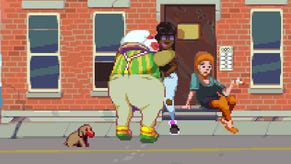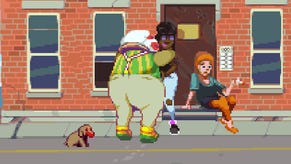Wot I Think: Dropsy
Clown in the dumps
Dropsy [official site] is a game in which kindness and love are hidden beneath smears and clots of greasepaint, and oedemic grotesqueries. It's perhaps fitting that the game itself contains moments of strange beauty hidden in the cracks of its cumbersome design but I'm not entirely happy in its clammy embrace. Here's wot I think.
Dropsy is a creepy clown who isn't actually creepy at all, and perhaps that's the entirety of the gag. Or the subtext. Outwardly terrifying (he's a clown after all, right?), he has a heart of gold but the only way he seems to be able to express his love for all things is by hugging everything and everyone. To my mind, that makes peoples' discomfort seem somewhat justifiable – they're often dealing with issues of their own when a clown walks onto the scene and tries to wrap his wiggly, wet arms around them. I'd probably hop away kicking myself in the arse as my fight-or-flight response blew a fuse attempting to cover all bases.
I'm not alone. Throughout the game, people often recoil from Dropsy when they first meet him and there's no judgement on them for reacting as they do. A lot of them are at their wits' end for one reason or another, and the game's brief introduction suggests people might have a reason to fear this particular clown. They're eventually won over by his innocence and desire to brighten their day, and my reaction to Dropsy the game was very similar to those reactions to Dropsy the character – there's plenty to love but you'll need to look past or learn to tolerate several off-putting features in order to find the good stuff.
Whether you'll find the process of befriending Dropsy worthwhile very much depends on your tolerance for stubbornly designed pointing and clicking. In fairness to the game, the obtuse nature of Dropsy's world is in keeping with the clown's character and the unusual course of his story, but that doesn't mean I've enjoyed deciphering many of the vague conversational clues or walking around in circles in an attempt to find NPCs as they shift around in sync with the day/night cycle.
Dropsy doesn't seem to understand language and cannot speak, so conversations are a combination of pictures in speech bubbles, gurgles and barks. At times, the content of a bubble helps to tell a story but more often than not, they're pointing toward a puzzle solution. The game rapidly introduces a stack of locations, a pile of characters and a heap of vague directions that I found myself sorting through and becoming increasingly frustrated. There's a correct order in which to do things – certain items, characters and combinations are only available when other tasks have been accomplished – but because so many locations are available so quickly, I was never entirely sure if I had a choice as to which puzzle I wanted to tackle next.
The day/night cycle didn't help. As you explore, the world forms loops of locations in which the screen I wanted always seemed too many clicks away until the merciful introduction of a fast travel option. Time passes as you move, however, and can be forced forward if Dropsy uses one of the 'beds' marked on his map. Some NPCs are only available during the day or night, and others move from one location to another. An entrance might only be available at certain times. There are some neat puzzles connected to the cycle but there isn't always any particular logic behind an NPC's change in behaviour or location, which leads to trial and error treks around the map in its two different phases.
The day/night cycle is one of the few embellishments that takes Dropsy away from the core traditions of point and click adventure games. On the whole you'll be trying every object stored in your voluminous pants on every character you meet in the hope that you'll banish their sorrows and win them over to your cause. Most of the puzzles involve bringing joy to the people and animals of the world, and there's often an obvious logic to their wants and needs, but sometimes Dropsy's world is almost impossible to understand.
That illogical or confused nature of things can be tremendously rewarding. An early jaunt across town to meet a friend became quietly devastating as the game revealed the gap between my understanding of the state of things and Dropsy's optimistic outlook. Even though the world seems determined to grind him down, through false accusations and assumptions, Dropsy treats every encounter as an opportunity to do good. That in itself won me over – playing games all day every day, I'm far more accustomed to earning multikill achievements than merit badges.
That initial delight of playing a kind character in a cruel world wore off as soon as I realised that I was expected to find round pegs for round holes and square pegs for square holes – objects that work to counter the particular misery of each character. Kindness as an inventory puzzle. Maybe that's a bleak joke to go with the bleak world that Dropsy inhabits; a whoopee cushion that sounds like a death rattle.
The game is at its best when it drops the creepy-clown stuff altogether, allowing its sometimes nonsensical presentation melt away to reveal an honest, hard truth. There are astonishing moments, micro-tragedies and dramas communicated through the animations of exaggerated sprites and conversations made up of repetitive pictographs. I found my interest drifting away whenever the weirdness was an actual facet of the town itself – or, in the weakest sections, Dropsy's nightmares - rather than simply the lens through which Dropsy saw ordinary things.
When the game's oddities seem to be about its main character's inability to read situations and behaviour, it functions as a touching allegory for all manner of otherness and confusion, but when it presents its strangeness as fact, it feels like an exercise in surrealist doodling. When that's the case, the day/night cycle and the too-vague clues became too much of a hindrance – I can just about accept structural obstacles if they work to inform my understanding of something larger, but when they're only there to prevent me from moving on to the next part of a story I don't particularly care about, I'm not quite so forgiving.
It's entirely possible that you'll respond much more kindly to Dropsy than I have. I wish it had been easier, with a second layer of clues accessible beneath the basic pictograph conversations perhaps. I also wish I'd felt more of a connection with Dropsy himself and I have no doubt that some people will. He's unfairly maligned and sweet, sure, but I'm far more interested in the barely suggested lives of some of the other characters. The introduction of a mystery in the intro places an emphasis on a bigger Dropsy-focused plot that never gripped me in the way that the smaller stories did.








